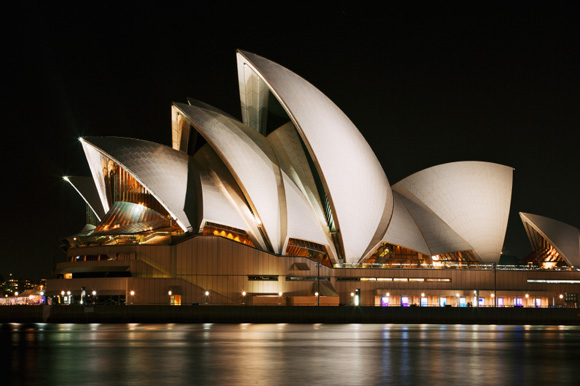Music rises to the heavens. Anyone who has ever attended an outdoor symphonic music concert or a large rock concert, like Pink Floyd, Metallica or Supertramp knows all too well. Even indoors we have the impression that the music wants to rise.
Danish architect Jorn Utzon completely understood. That’s the origin of his Opera House in Sydney, Australia, whose roof appears to have been designed to let the music escape through the openings. The unique building was inaugurated in 1973, but 40 years later, it is still the envy of architects the world over.

Everyone interprets the work their own way. To some, it represents a series of shells; for others, sails. Tourists probably have their own serious and outlandish interpretations. Who’s right?
They are shells. At least that was Jorn Utzon’s intent. And the choice of shell is not surprising when you learn that the building is located in the port of Sydney and that Utzon was the son of a naval architect who built ships and yachts. The sea, the beach and the sand appear to be an integral part of the Utzon family’s universe.
Are you a numbers fanatic? Wikipedia has an all-you-can-eat buffet. The roof is made up of 1,056,006 white ceramic tiles. A great traveler, Utzon fell in love with Japan and the type of bowls he used as inspiration for the tiles.
The Opera House is supported by 588 concrete pillars that are driven up to 25 metres below sea level. It consumes enough electricity for a city of 25,000, or the population of Magog, St-Jérôme or Rivière-du-Loup. Electricity is distributed by 645 kilometres of electrical cables.
Incredible but true: not only was the architect not invited to the building’s inauguration in 1973, where he would have rubbed elbows with Queen Elizabeth II and enjoyed Beethoven’s Ninth Symphony, but his name wasn’t even mentioned. Why? Because once it got into power, a rather chauvinist government forced the architect to quit, preferring to confide the rest of the work to local firms, much the same as architects of the era, highly aware that they were witnessing the birth of a masterpiece.
The government had a very valid pretext: exploding costs. Like most colossal achievements, construction of the Sydney Opera House ended up being a real puzzle, with the number of unexpected events constantly multiplying. Estimated at $7 million Australian dollars before the work began, the total bill amounted to $102 million. Utzon quit three years after the work started, which lasted for ten years.
The Sydney Opera House represents a leap in the evolution of architecture, both in terms of design innovation and the use of certain materials. Utzon was one of the first, if not the first, to use a computer for analysis purposes.
Many books have been written on the building’s history, its political saga and the audacity of its construction (supported by numerous drawings).
The Sydney Opera House is on the UNESCO World Heritage List. Some 7 million tourists visit the building each year. It is considered to be one of the most spectacular buildings of the 20th century.
It has become the symbol of Australia, like the Eiffel Tower in France and the Leaning Tower of Pisa in Italy.
References:
Sydney Opera House English Wikipedia article
Opéra de Sydney French Wikipedia article
Utzon, Jorn English Wikipedia article
Jorn Utzon French Wikipedia article